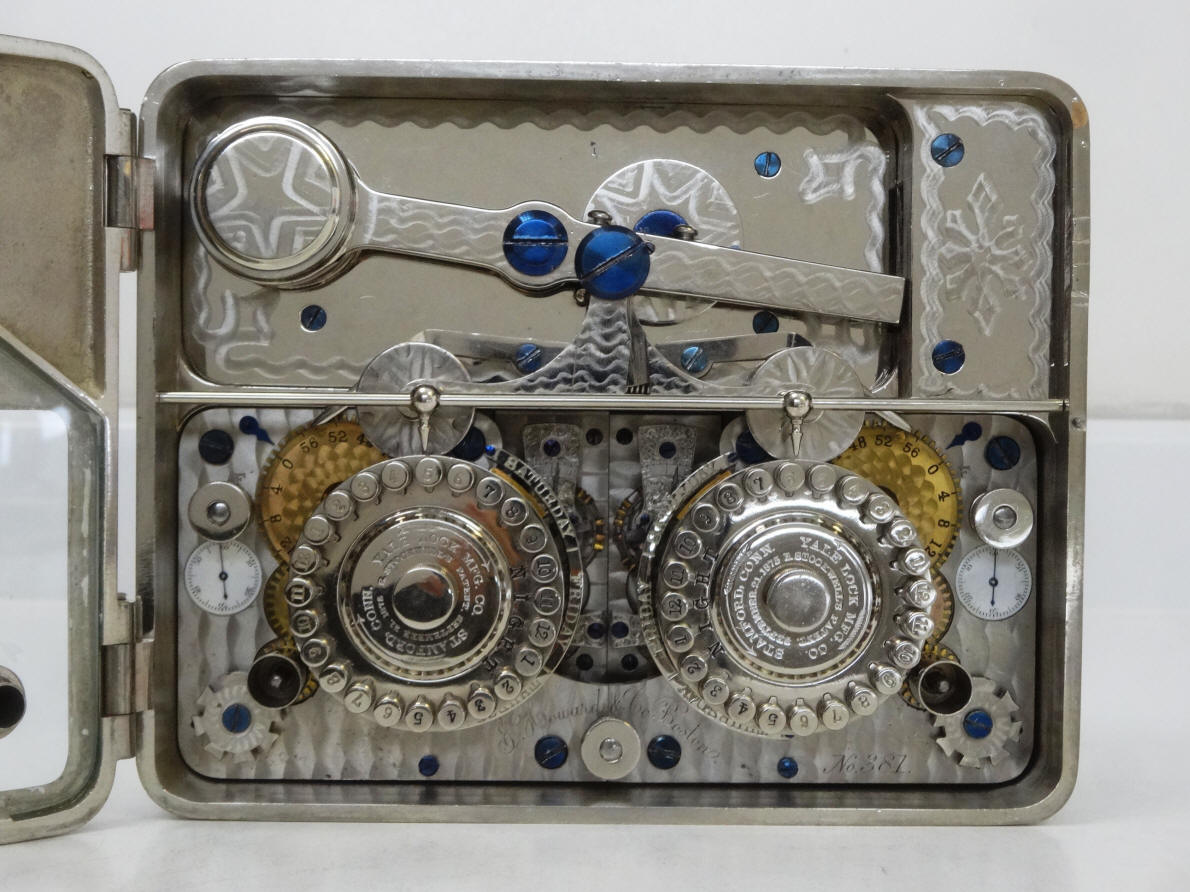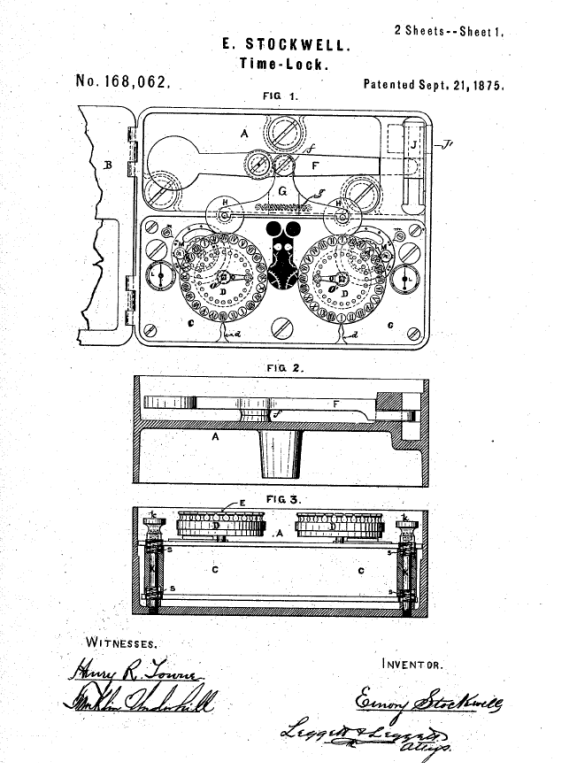|
Yale Lock Manufacturing Co., Stamford, Connecticut - Model No. 1, Double Pin Dial with Sunday dial attachment, v.1, v.2, v.3
To protect the timer movements from stopping if the vault's boltwork is jammed or forced against the bolt dogging block (J), Mr Stockwell designed a split yolk (G) held together by a spring (g). If upward motion of the counter-balanced lever (F) is impeded, the spring (g) permits the two sections of toke (G) to separate and the rollers rise up and down on their friction pins without stopping the movements. When the obstruction or impediment is removed, the operation of the spring (g) will raise lever (F) and block (J) to the locked position. Refer to second sheet of patent illustration above. A. Yale Model No: 1, v.1, c.1876. Double Pin-Dial Time lock with optional Sunday dial attachment. (1). This was Yale's first time lock, and is probably one of the finest, complex and more beautiful ever made. First available with 56 hour duration, although there is a 48 hour example with a later serial number, perhaps a retrofit. An extremely expensive item the standard version was $400. This example has the optional day of the week attachment, commonly known as the 'Sunday dial' (2), and was available for an extra $50 evidenced by the ring indicating the day of the week around each pin dial. This lock is prior to the advent of the 'modular design' where individual movements were interchangeable. The movements were made by E. Howard & Co., Boston, one of the finest watchmakers of the period. Howard continued to supply Yale as well as other companies (Hall/Consolidated, Diebold) with movements until 1902. Although a complex and expensive lock, it was popular and Yale made over 2100. This lock, however is a very early in the series, and these were distinguished by the lack of any patent dates on the bolt dogging plate, the use of Geneva stops on the front movement plate (later moved to the rear side of the winding barrels), silvered platform escapement cocks which later were gold plated and afterward left in brass. Also the milled diamond pattern on the case is smaller than on later models in the series. It looks like cases numbering after 500 had the larger diamond design as seen in example B and C below. 7 1/4"W X 6"H X 3"D, Movement #381, case #433. file 273 B. Yale Model No: 1, v.3, c.1887. Double Pin-Dial Time lock with optional Sunday dial attachment. (1). This was Yale's first time lock, and is probably one of the finest, complex and more beautiful ever made. Available with either 56 hour or, as in this example after 1885, 72 hour movements. An extremely expensive item the standard version was $400. This example has the optional day of the week attachment, commonly known as the 'Sunday dial' (2), and was available for an extra $50 evidenced by the ring indicating the day of the week around each pin dial. This lock is prior to the advent of the 'modular design' where individual movements were interchangeable. The movements were made by E. Howard & Co., Boston, one of the finest watchmakers of the period. Howard continued to supply Yale as well as other companies (Consolidated, Diebold) with movements for many years. Although a complex and expensive lock, it was popular and Yale made over 2100, therefore this lock for it's age is fairly common with over 400 known survivors of which 50 have the Sunday Attachment option. Movement #1710, case #968. file 51 C. Yale Model No. 1, v.2, c. 1878. The same version as 'A' but a bit later as this one is equipped with 56 hour duration timers, the patenet dates are displayed on the bolt dogging plate, the Geneva stops are moved to the rear of the winding barrels and the platform escapement cocks are gold plated. The case and movement are in beautiful condition in this example. Movement #1005, case#780, file 162 A feature unique to this type of time lock (pin dial) is that as well as being ' off guard ' it can go ' on guard ' in accordance with the settings of the pins. As such it is designed to run continuously, unlike the majority of time locks which go off guard when they run down. However, if the movements are allowed to stop completely they will take the lock off guard, despite the settings of the pins. The description of how the pin dials work is below:
The Yale time lock contains two chronometer movements which
revolved two dial plates studded with 24 pins to represent
the 24 hours of the day. These pins, when pushed in, form a
track on which run rollers supporting the lever which
secures the bolt or locking agency, but when they are drawn
out the track is broken, the rollers fall down and the bolt
is released. By pulling out the day pins, save from 9 until
4 the door is automatically prepared for opening between
these hours, and at 4 it again of itself locks up. For
keeping the safe closed over weekends and holidays, a
subsidiary segment of track is brought into play by which a
period 24 or more hours is added to the locked interval.
Careful provision is made against the eventuality of running
down or accidental stoppage of the clock motion, by which
the rightful owner might be as seriously locked out as the
burglar.
Compare this model to the Yale single pin dial (a rarer version).
An original Yale advertisement c. 1876. Notice that the time lock is
upside-down! This document shows the interesting (confusing) numbering
system Yale used for their Double Pin Dial models. Next is a Diebold safe equipped with a Yale double pin dial.
The medallions are on
Yale’s Double dial bank lock with the two sides of the (1) The pin dial is clearly a far more complicated design than Sargent & Greenleaf's Model 2, offered a number of innovations, the most obvious being the two front dials, each with series of twenty-four pins. Every pin, embossed with an hour of the day, could be pushed in, locking it, making the Pin Dial the first time lock capable of both unlocking and locking a safe at a predetermined time. Further the Pin Dial was the only mechanical time lock ever to be able to lock, unlock, and re-lock a safe for various one-hour periods throughout the day. American Genius Nineteenth Century Bank Locks and Time Locks, David Erroll & John Erroll, pp 164. (2) In 1876 Yale added the Sunday Attachment, which allowed the lock to skip the opening periods each Sunday. The mechanism is identified by two curved nickel runners next to the inner top third of the pin dials embossed with "Thursday Friday Saturday" and a small shield on each dial that is geared to rotate at one-seventh the rate of the dial. These shields move over the the names of the days, allowing the user to check to make sure it is accurate, and then, during the twelve hours Sunday day, will be interposed between the drop wheel and the pins, guarding the opening of the pulled pins and keeping the lock shut. This option was available after 1885. American Genius Nineteenth Century Bank Locks and Time Locks, David Erroll & John Erroll, pp 164. |

 A
A


